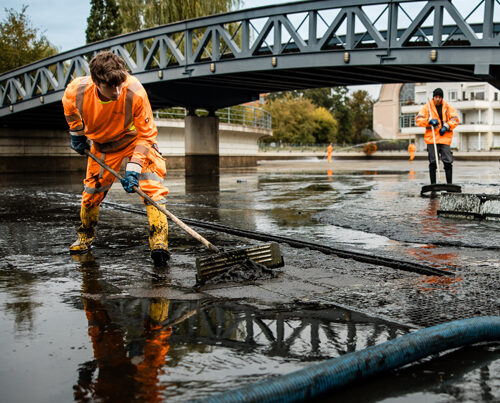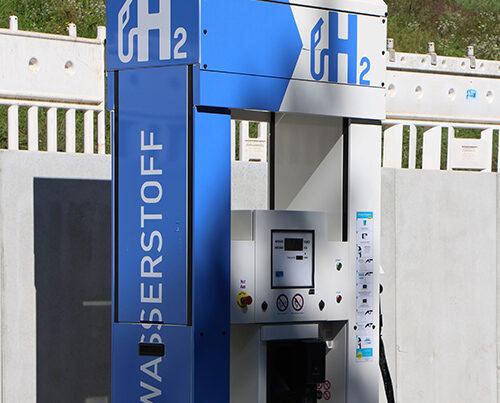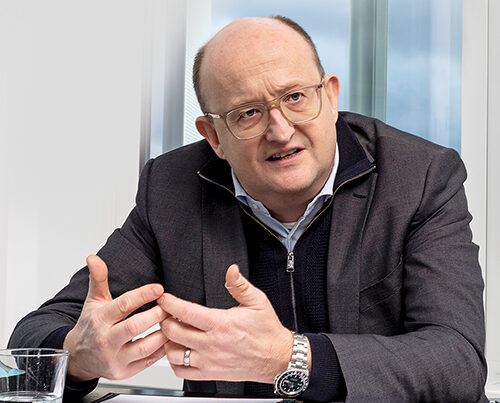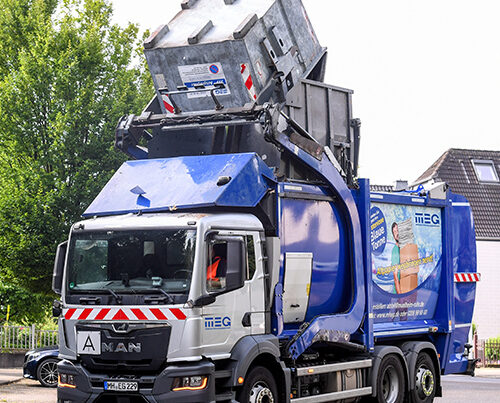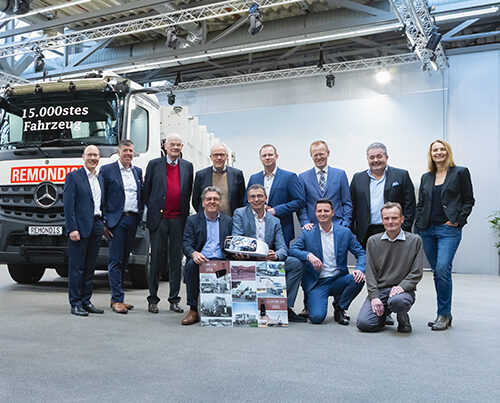Since August 2021, public sector clients have had to take Germany’s Clean Vehicle Procurement Act [Saubere-Fahrzeuge-Beschaffungs-Gesetz] into account when issuing new tenders. Logistics expert Sascha Hähnke, managing director of REMONDIS Sustainable Services GmbH, explains which alternative drive systems are currently being considered for municipal commercial vehicles, which ones are available and which ones will prevail.
Dear Mr Hähnke, you are working intensively on the topic of alternative drive systems. You are in favour of diversity on the road. Is that why you are a welcome guest on discussion panels and podcasts about the transport transition?
Sascha Hähnke: Yes, that’s certainly one reason. The other reason is that I always speak plainly about what we want and what we do. Nice packaging leads to a false perception. If, on the other hand, you address problems and issues clearly, you are often invited to such panel discussions. The biggest problem is that I often don’t say what is already possible. I tend to criticise the things that aren’t really working yet. Germany, for example, has a really great funding programme for alternative drive systems. An incredible amount of money is being made available so that you can get started.
The mix of alternative drives makes the difference
The German government wants to have 7 million electric vehicles on German roads by 2030. For this, 1 million charging points must be created. Innovative solutions and funding programmes should drive the expansion forward. Can we achieve this?
Sascha Hähnke: The figure applies to private households, I can’t estimate that. For logistics, i.e. the lorry sector, it is true that the first Scandinavian manufacturers have produced series cars that can be bought. Germany is also endeavouring to do this, but it will still take some time. There is also a lack of charging stations. Personally, I also think it’s a fairy tale that after a four-hour drive, when a lorry has to take a break, there will just happen to be a free fast-charging station on a motorway. There is no public infrastructure for lorries for this. This is left to the private sector.
A third problem is that diesel will not disappear just because electromobility is coming. No petrol station operator is going to demolish a diesel filling station and build a charging park instead. Or even demolish a diesel filling station and build a hydrogen filling station instead. As diesel will be around for a long time to come and we are only slowly growing into alternative drive systems, we need diversity. We need additional space for hydrogen refuelling stations and electric charging stations. That’s what I have the most respect for.
„The problem is what we put in it and what comes out of the exhaust. We need the right fuel, for the right application, in the right engine, with the right investment.“
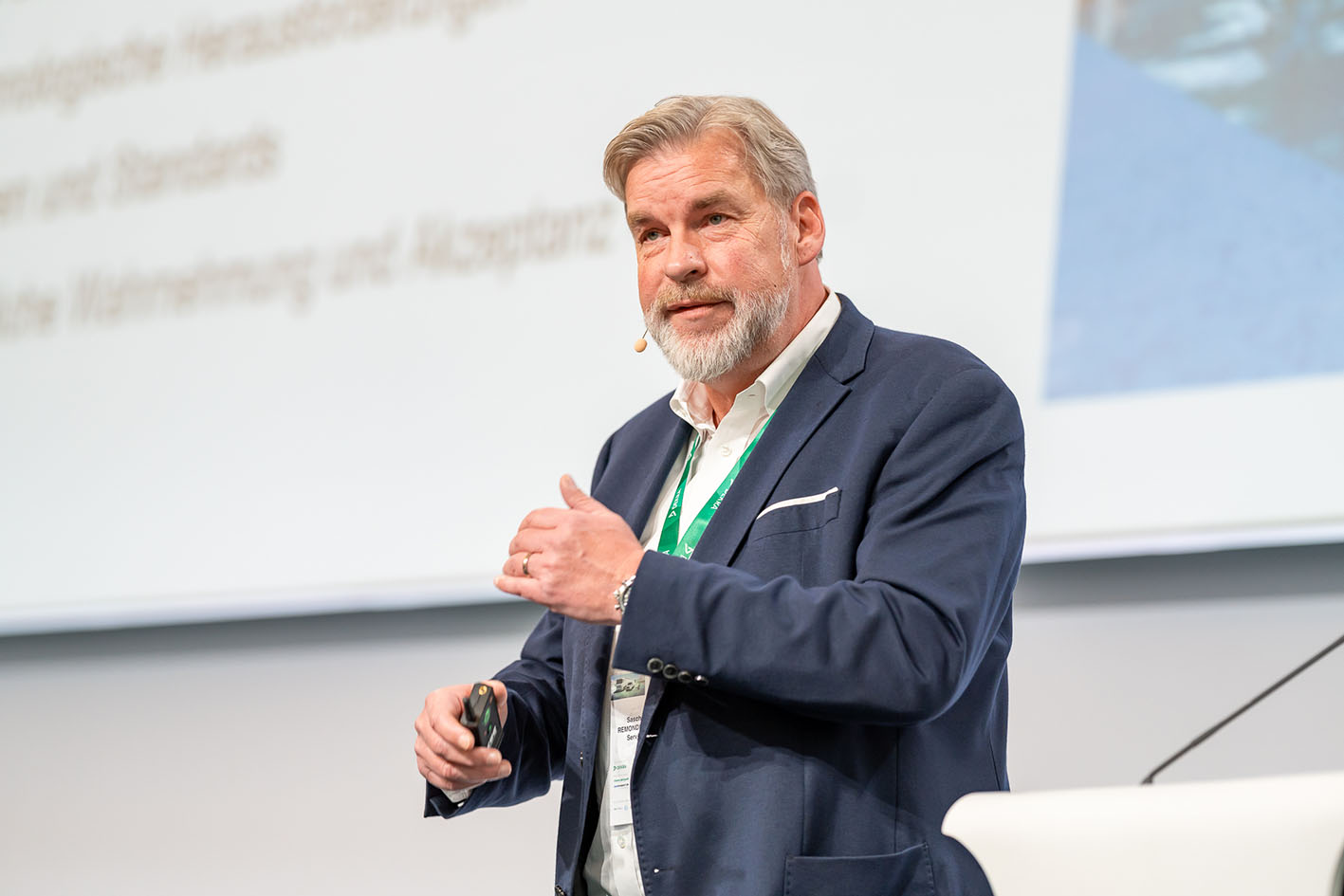
Sascha Hähnke as speaker at the Zukunftskongress Nutzfahrzeuge in Berlin in October 2023
Is there another reason why you are in favour of a mix of alternative drive systems?
Sascha Hähnke: If we as a company want to be open to technology, then we need to talk not only about electric or hydrogen vehicles, but also about engines. The electric motor, for example, doesn’t care where the electricity comes from. Whether it comes from the fuel cell or the battery. We are having an ideological discussion here. The combustion engine itself is not the problem at all. The problem is what we put in it and what comes out of the exhaust. We need the right fuel, for the right application, in the right engine, with the right investment.
Where does Germany currently stand in the development of alternative drive systems and which ones will prevail in private households, transport logistics and municipal vehicles?
Sascha Hähnke: I believe that electromobility will prevail in the passenger car sector. At the moment, these vehicles are just too expensive at an average of just over 50,000 euros for a new car. However, the variety of models that we have in the combustion engine sector is not yet available. There will clearly be a mix for lorries. On the one hand, the combustion engine will play a major role. On the other hand, we are often on the road with biogas vehicles, especially in the recycling industry, and we will continue to pursue this path consistently, as well as driving with HVO biodiesel.
How could the key public services of a municipality, such as urban cleanliness, public transport or waste management, become clean in terms of transport technology? Could overhead lines be used, for example?
Sascha Hähnke: Unfortunately, there are only three test routes for overhead lines in Germany. REMONDIS’ sister company, Rhenus Contargo, is currently travelling on the A5 motorway. Unfortunately, the overhead line is switched off from time to time for safety reasons. This is therefore not yet a reliable alternative. I see it more as an additional loading option. In the context of municipal collection, the depot of a medium-sized city will reach its limits even with electric mobility. It makes a difference whether I charge three lorries electrically or 30, in which case I have to invest properly as it is not enough to simply build charging points. Irrespective of any funding, factors such as the energy supplier, the transformer or the supply line etc. play too important a role here.
Municipalities lack planning certainty
Most people are familiar with the Clean Vehicles Directive and the law on the procurement of clean road vehicles. As a municipal decision-maker, how do you start implementing them?
Sascha Hähnke: Here we start with an inventory. This is still relatively simple. For example, I can measure and evaluate traffic flows. However, there is no planning certainty. In June, we had no idea that the lorry toll would almost double. We don’t even know how long the subsidy programme for alternative drive systems will continue and, if so, how much it will be. Under these circumstances, urban planning cannot plan for six or eight years. However, it needs this planning period in order to develop a sensible refuelling and charging infrastructure.
What advantages do I have as a local authority if I establish a public-private partnership (PPP) to drive forward the transport transition locally?
Sascha Hähnke: A PPP has the great advantage that the private sector partner knows exactly what works and what doesn’t thanks to the variety of technologies available. We at REMONDIS can advise a local authority and report on our experience with other PPP or from our associated companies. This type of advice is also relevant for the funding landscape. If a local authority wants to invest in alternative drive systems, we can tell them what is currently being subsidised and what is not. We have also advised two or three committees for the Ministry of Transport. Incidentally, this is no easy task.
What successes has the private sector recently brought to politics?
Sascha Hähnke: In addition to some wrong decisions by the Ministry of Transport, the Federal Government’s 2.2 billion euro funding programme was a great help. We advised the Ministry of Transport back then and drew up a position paper. We did this without associations, without our lorry manufacturers. Together with three private-sector companies, we approached the Ministry and pointed out that something had to happen if more lorries with alternative drive systems were to drive on the roads and how we envisaged this. Of course, not everything was implemented, but some things were.
When the funding programme came along, some local authorities submitted applications. However, all collection vehicles were rejected. For this reason, a special funding programme for municipal vehicles was launched in a second round. Our task here was to advise local authorities. The idea of establishing a special funding pot for municipal vehicles, which would be evaluated and compared with each other, was a success. The first municipal vehicles then received a positive funding decision. We are currently in the second funding round of the KsNI funding programme for climate-friendly commercial vehicles and infrastructure. The 3rd call for funding was originally due to start at the end of the year. In view of additional lorry toll revenues amounting to almost 8 billion euros per year, we must be able to assume that the funding pots will be replenished. If not, Germany will be taking a break on climate protection for commercial vehicles for the time being.
HVO – the synthetic fuel of the future
Let’s talk about HVO and developments for combustion engines with HVO as a synthetic fuel. What exactly is behind it? What are the advantages and disadvantages?
Sascha Hähnke: HVO (Hydrotreated Vegetable Oil) is not comparable to the biodiesel that we used on a large scale in the early 2000s. It is a synthetic fuel that is primarily produced from used vegetable fats, not palm oil, and therefore has limited availability. We cannot yet estimate how long this resource will be available, but plantations will certainly not be planted as a result. Mineral oil traders say that there is still enough biogenic input material in stock at the moment. But what does enough mean when thousands of lorries are being converted to HVO? I fear that we will come up against limits in terms of availability. Another disadvantage is that something that is naturally limited will eventually become expensive.
If you go to the website of the Federal Ministry of Transport and search for alternative drive systems that fulfil the Clean Vehicles Directive, you will find HVO biodiesel. In order to use it, cars do not have to be retrofitted, lorry maintenance intervals do not have to be shortened and filters do not have to be replaced earlier than usual. You can actually start refuelling and rethinking tomorrow. Depending on the expert opinion, you can save between 70 and 80 % CO2. At the moment, this biodiesel costs around €0.20 more than mineral oil diesel.
Why is synthetic diesel, with its 80 % CO2 savings, not a much bigger topic in the public discourse on alternative drive systems?
Sascha Hähnke: The Ministry of Transport is of the opinion that HVO complies with the Clean Vehicles Directive; the Federal Ministry for the Environment, on the other hand, has not yet approved this fuel for use on the roads. This means that it cannot yet be purchased at a public petrol station, but can only be filled up at the company’s own petrol station. This is absurd, but a fact. Why two ministries think so differently can only have something to do with the ideological discussion about phasing out the combustion engine. We are no longer talking about the fuel it contains or CO2 savings, but generally about whether a combustion engine is allowed or not. From next year, however, it will finally be possible to fill up with HVO at petrol stations.
Hydrogen, electromobility, biogas and HVO biodiesel
Concerning the Clean Vehicles Procurement Act: politicians are driving forward the transformation here, ten per cent of the vehicle fleets of cities and municipalities must be converted to alternative drive systems. Which municipality comes to mind as a prime example?
Sascha Hähnke: Frankfurter Entsorgungs- und Service GmbH (FES), for example, only uses electric vehicles. We have a waste incineration plant there and a charging park where public transport buses, municipal collection vehicles and our electric articulated lorries for the plant’s subsequent transports charge. They all share a charging park. That’s a holistic concept, as I imagine it should be for a city. As a private-sector partner, we also work closely with the public transport system. In addition, we have electrified the subsequent transport of the systems via the same charging unit. Nevertheless, Frankfurt will also order a hydrogen car because it does not want to close its mind to other alternative drive systems.
The city of Freiburg, on the other hand, which we are also working with, is focussing on hydrogen. There are already nine vehicles here, and six more will be added at the end of the year. Nevertheless, Freiburg has also bought electric cars and, like Frankfurt, is using a variety of vehicles in parallel. For me, these are prime examples for local authorities. However, I emphasise that you really have to want all of this and that you need the right PPP partner for it. You also need the political will on the part of municipal decision-makers.
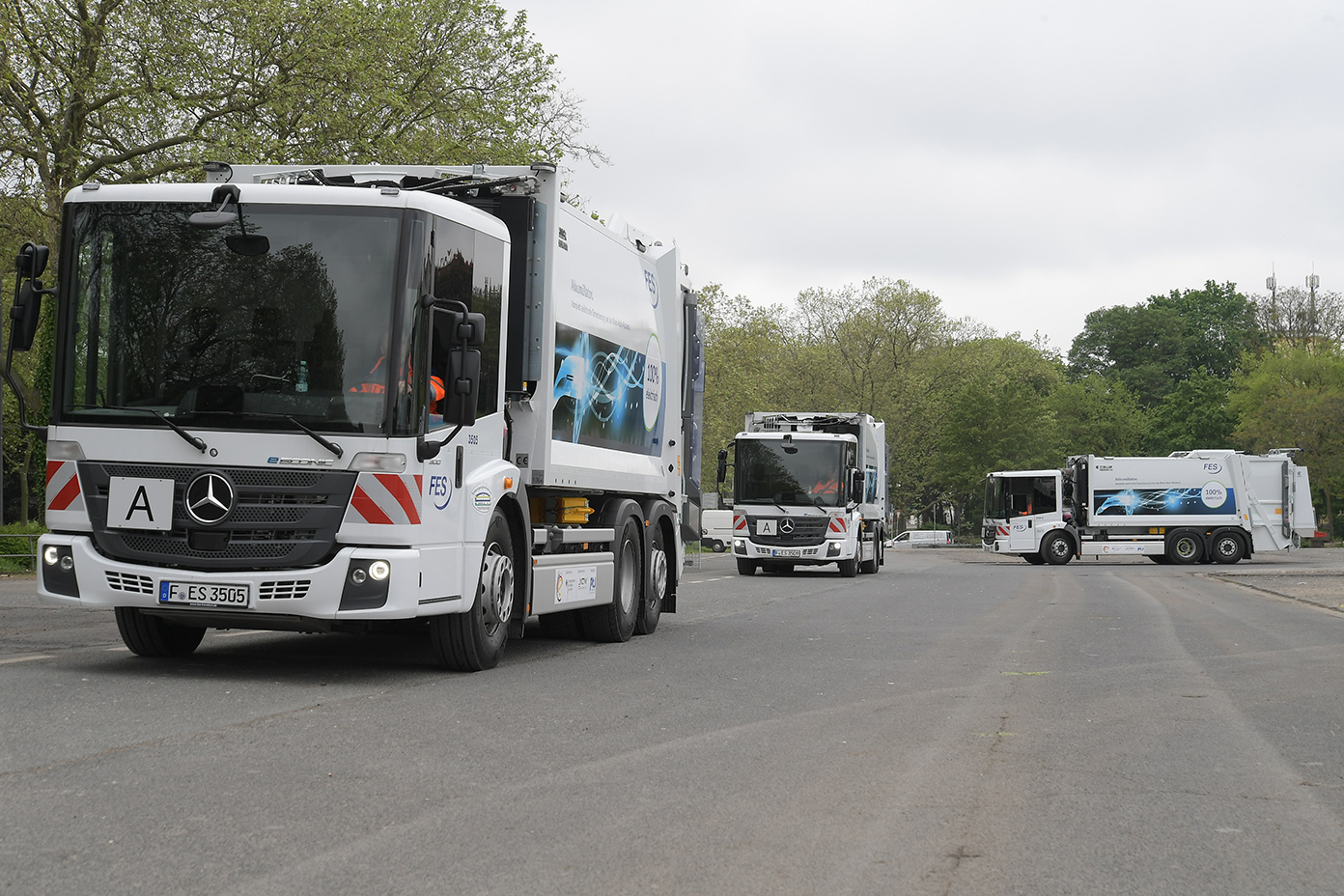
FES and FFR have added 10 battery-electric trucks to their fleet
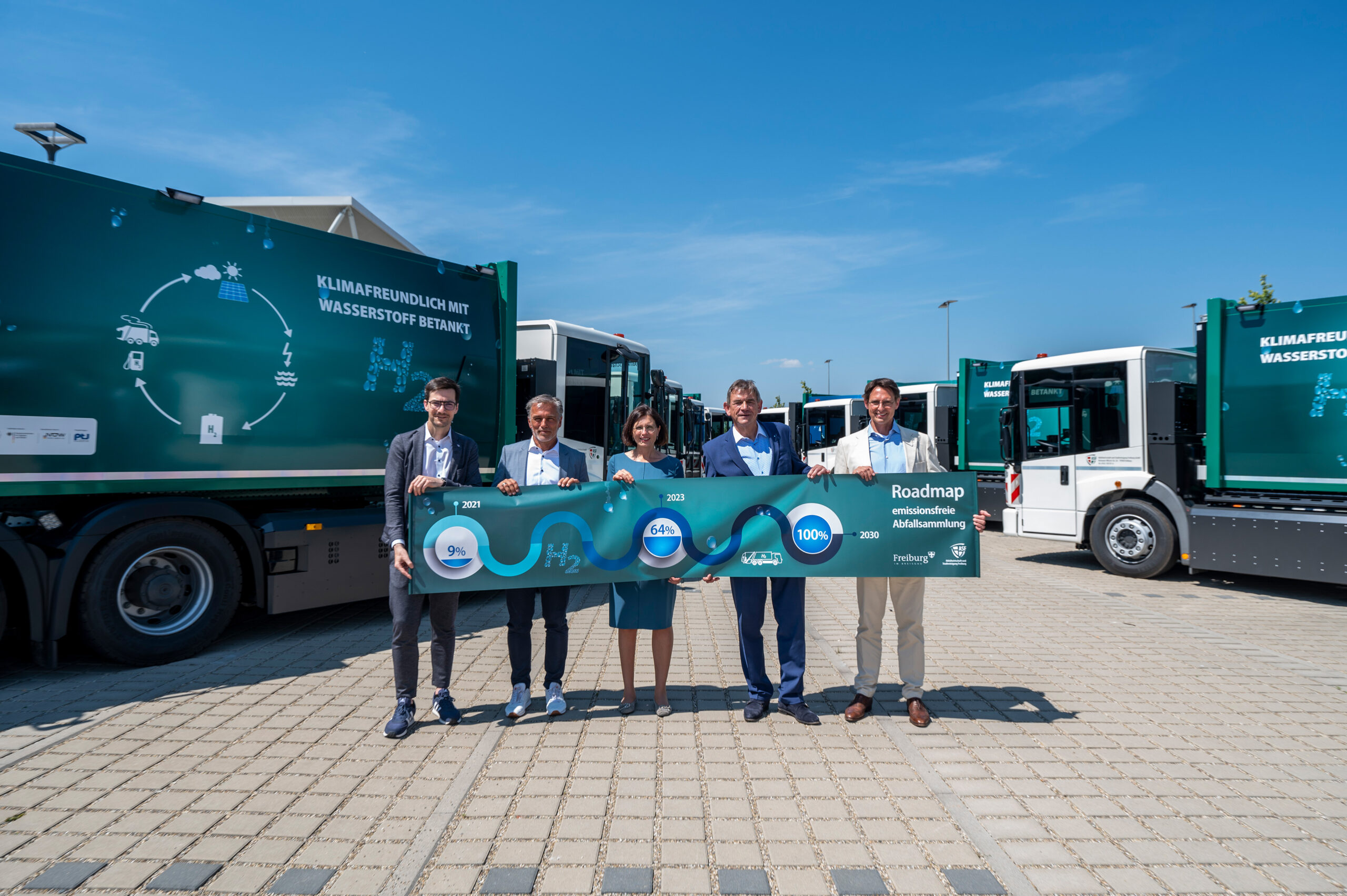
ASF has expanded its fleet to nine fuel cell vehicles
How should municipal decision-makers proceed when planning their vehicle fleet? Where can they get help?
Sascha Hähnke: The first advice is to take stock: what do I have in the city and what is possible with my infrastructure? The second advice is to simply start with something small. And thirdly, it is important to get help from partners who have been through this before.
From a logistical point of view, are there any other considerations that a local authority should make?
Sascha Hähnke: In general, collection vehicles do not travel for free. REMONDIS Digital Services provides suitable IT tools, such as dynamic route planning, to further optimise collection routes. If these vehicles are also powered by alternative fuels, then this is the ideal solution.
What would you like to see in local or federal politics over the next five years?
Sascha Hähnke: Addressing our wishes to the local authorities is the wrong approach. Because at the end of the day, they are at the navel of the federal government. But what we want from federal policy is this: We need to define the Clean Vehicles Directive differently. The bandwidth we have there is simply too large. We would also like to see speed in the bureaucracy and transparent eligibility criteria. Last but not least, we would like to work with all drive systems in a way that is open to all technologies. Because if we only rely on one drive system, then we’ll be left behind.
Thank you very much for the interview!
Municipalities need partners: Knowledge portal as a trailblazer
The interview first appeared on www.klimaschutz-kommune.info. Since December 2021, the information platform (in German) has been informing cities and municipalities about environmentally friendly and sustainable administration, management and living. The focus is on modern services of general interest as a cross-sectional task.
The website, initiated by REMONDIS Sustainable Services, accompanies municipalities on their way towards a sustainable environmental service branch and, above all, highlights the value of cooperation. Municipalities are faced with huge challenges that can hardly be overcome on their own.

Image credits: image 1, 2: © Thomas Küppers/ETM-Verlag; image 3: FES; image 4: Seeger/Stadt Freiburg, image 5: Agenda 17







